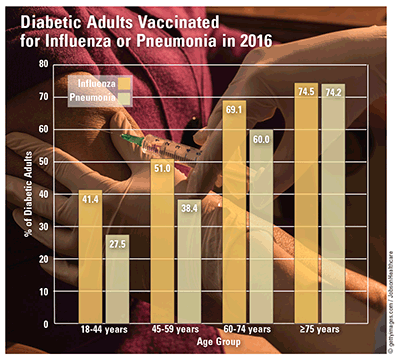US Pharm. 2018;43(4):45.
According to the 2015 National Diabetes Statistics Report, 30.2 million persons aged 18 years and older with diagnosed (23.1 million) and undiagnosed (7.2 million) type 1 and 2 diabetes were at higher risk for developing vaccine-preventable diseases such as influenza and pneumonia. Among diabetic adults, the prevalence of vaccination for influenza was higher than that for pneumonia (61.6% vs. 52.6%). The CDC recommends annual vaccination for influenza, regardless of age, and at least a one-time dose of pneumococcal vaccine, which has prevented 3,000 deaths.

Influenza Hospitalization: Because diabetes onset increases with age, comorbid illnesses—such as influenza—that raise blood glucose to dangerously high levels are a major concern. People with diabetes are three times more likely to die from influenza complications and six times more likely to be hospitalized. In 2015, during the H1N1 pandemic, one in every four persons hospitalized for influenza had diabetes. Since 2010, there have been 140,000 to 710,000 influenza-related hospitalizations and 12,000 to 56,000 deaths that could have been prevented or reduced by vaccine types A and B, whose effectiveness ranged from 25% to 67%.
Influenza Vaccination: Nearly two-thirds (61.6%) of adults with diabetes were vaccinated for influenza. In patients aged 65 years and older, complications led to rates of 54% to 70% and 71% to 85% for seasonal influenza-related hospitalizations and deaths, respectively. Influenza vaccination during the 2015–2016 influenza season prevented 5.1 million illnesses, 2.5 million medical visits, and 71,000 hospitalizations. The percentage of diabetic adults who had an influenza vaccine in the past year was lowest among those aged 18 to 44 years (41.4%), followed by those aged 45 to 59 years (51.0%), 60 to 74 years (69.1%), and 75 years and older (74.5%). Since the 2009 approval of the high-dose vaccine, there have been 24% fewer influenza infections in persons aged 65 years and older. Nearly 51% of poor adults with diabetes had an influenza vaccine, versus nearly 58% of near-poor and 65.9% of not-poor diabetic adults.
Pneumonia: Persons with diabetes are at increased risk for death from pneumonia. Overall, 52.6% of adults with diabetes received a pneumococcal vaccine. The rate of vaccination for pneumonia increased with age: 27.5% (for age 18-44 years), 38.4% (45-59 years), 60% (60-74 years), and 74.2% (75 years and older). Approximately 42% of poor diabetic adults, 51.5% of near-poor diabetic adults, and 55.7% of not-poor diabetic adults had ever received a pneumococcal vaccine. The CDC recommends that adults aged 65 years and older keep up-to-date with pneumococcal vaccination to protect against diseases such as pneumonia, meningitis, and bloodstream infection.
To comment on this article, contact rdavidson@uspharmacist.com.





